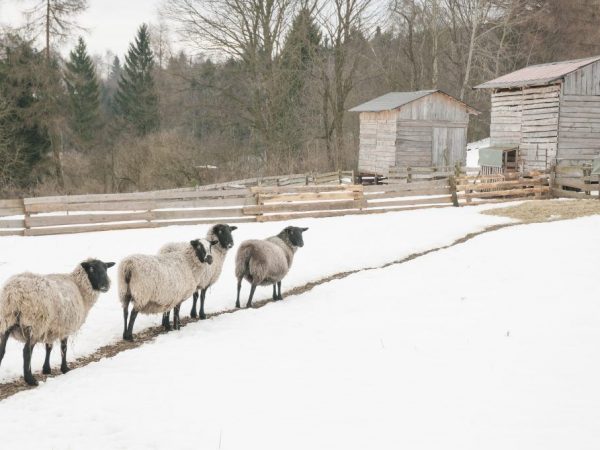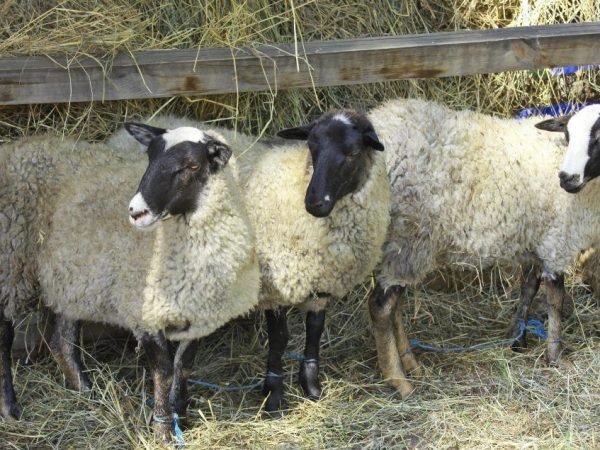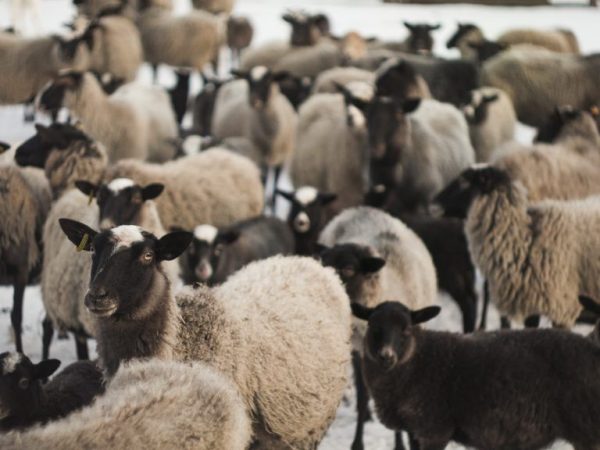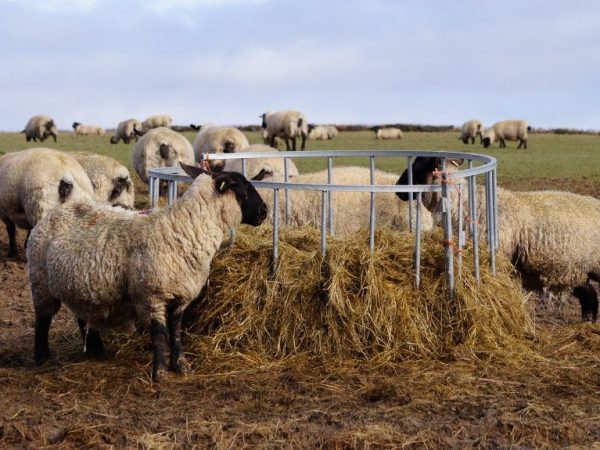Description of the Romanov breed of sheep
Sheep breeding from time immemorial has been considered a profitable enterprise, however, it is impossible to call this occupation simple even with a stretch. Despite the difficulties, many still choose this type of activity as a way to earn money and achieve good results at the same time. The fact is that this type of animal husbandry is different in that animals quickly gain weight and grow. Among the advantages, one can also note a low mortality rate. Sheep meat is incredibly tasty, the same goes for milk.
- The history of the emergence of the breed
- Benefits
- Is it profitable to keep Romanov sheep
- Features of purebred Romanovs
- general description
- Features of the content
- Organization of feeding representatives of this breed
- Nutrition of Romanovoks in the summer
- Organization of caring for Romanov sheep in winter
- Breeding features of this breed

Characteristics of sheep of the Romanov breed
When starting a business with sheep, many people think about which breed they will choose. Experienced breeders note such a variety as the Romanov breed of sheep. On the territory of Russia and the countries of the former USSR, it is the Romanov breed of sheep that is in first place in the ranking of relatives. Next, we will find out what the advantages of this breed are.
The history of the emergence of the breed
Romanovka was obtained in the distant 18th century through long-term selection work. The goals that the breeders faced were as follows:
- unpretentiousness;
- fertility;
- fast weight gain.
Everything conceived came true, because the breed is valued precisely for these qualities. It is important to mention that this achievement in the field of animal husbandry belongs to domestic zootechnicians, because all breeding work was carried out on the territory of Russia, in the Yaroslavl region. The cattle breeders liked the new breed so much that in the first years after the breeding of the Romanov sheep one could find almost in any corner of the world, from North America to Tatarstan, Kazakhstan and Bashkiria.

The emergence of the Romanov breed
Animals of this breed are usually referred to as a mixed direction. This means that a sheep can produce not only meat after slaughter, but also excellent high quality wool throughout its life. As mentioned earlier, the most important feature of the described breed is that sheep are able to take root in almost any climate. This is especially true for Russia, where the difference between the temperature in summer and winter can be more than 50 ° C.
Benefits
Speaking about the Romanov breed, I would like to once again emphasize all the advantages, because of which you should opt for it:
- high quality wool;
- tender tasty meat with maximum yield;
- excellent adaptability to environmental conditions;
- unpretentiousness in care and feeding.
Currently, the breed is bought not only for growing and breeding in its pure form, but also to improve the qualities and descriptions of other breeds when crossed with Romanovka, in order to prevent a cross.
Is it profitable to keep Romanov sheep
As mentioned earlier, the Romanov breed sheep are beneficial for breeding and keeping.Sheep of the Romanov breed are just as popular. Animals gain weight rapidly, even with the most meager nutrition. So, if the nutrition of a lamb consists of half a kilogram of grain and only 1 kilogram of hay, after 6 months it will weigh more than 50. When slaughtered at this age, the waste part of the carcass is no more than 50%. It is recommended to slaughter sheep exactly at the moment when they weigh 50 kg, usually around the age of 8 months.

Maintenance of sheep of the Romanov breed
Despite the fact that sheep and rams are bred for meat, do not forget that there are other livestock products that can be obtained from it. In addition to meat, you can sell wool, milk, leather. On average, about 3 kg of excellent fleece are obtained from one Romanov sheep, which is a worthy indicator among other breeds.
How many times should a sheep be sheared? Shearing of these animals should take place at least 3 times a year, and this must be done strictly before the molting period begins. Many livestock breeders are trying to develop their business further and begin to make products from sheepskin and wool on their own, this brings additional income, allows you to quickly complete the business plan.
Features of purebred Romanovs
Romanovsky sheep and Romanovsky sheep differ not only in performance characteristics, but also in external features. This variety belongs to quite large, such lambs have a short tail and gray hair. Flakiness does not belong to the characteristics of the breed; horns can be present on the head of both the male and the female.
It is customary to divide animals according to the line of skeletal development:
- strong;
- rude;
- tender.
The first group of animals with a strong skeleton combines sheep and rams, symmetrically folded, with a well-built skeleton, suggesting the presence of a wide chest. Such animals have thick hair, soft to the touch. The difference is in the color of the wool: in this subgroup it has a dark graphite color. Many people confuse such Romanovka with Altai or Stavropol sheep.
Romanovs with coarse bones are characterized by coarse wool to the touch. Males differ from their counterparts in that their mane is thicker and has several shades. Despite this, according to the criterion of wool quality, this group is inferior to the previous one, which cannot but affect the price of the product. If we compare productivity indicators, they will overlap with those that are attributed to the North Caucasian breed of sheep.
The third group of sheep with a delicate skeleton is the most unclaimed, flaws can be seen even with the naked eye. Such animals have a narrow skull shape, a narrowed rib cage and an underdeveloped sacrum. The wool of such a sheep looks different: it is painted in a snow-white color, this is the first thing that catches the eye when looking at a photo or video. It is worth saying that such a subspecies is in the least demand due to the fact that the quality of the fleece and meat, including, is significantly deteriorating.
general description
To describe the breed of Romanov sheep completely, one should dwell on the features of the exterior. The characteristics of the Romanov breed of sheep are as follows:
- weight of animals: female - up to 50 kg, male - up to 85 kg;
- fertility indicators: at one time the farm increases by 4-5 individuals.
In addition, there are the so-called breed standards, the maintenance and breeding of Romanov breed sheep at home will be impossible without this knowledge obtained with the help of the scientist Pavel Kuleshov:
- the growth of the sheep should be medium, bends at the withers or rump are not allowed;
- the chest should look powerful, the limbs are symmetrical;
- the wool is densely located, the underpads should protrude slightly;
- coat color - from dark (black) to cream;
- down and wool in a high-quality fleece should be correlated in a ratio of 1 to 5;
- a different color of wool is allowed when it comes to young animals.
Features of the content
Does the breeding of Romanov sheep require special conditions? As has been said many times earlier, such animals do not require any special conditions of detention, since they are classified as unpretentious. This is largely due to the fact that the sheep have dense wool, which does not allow them to freeze in the cold and does not allow them to overheat in the summer heat. There are cases when Romanovskie sheep lived in Siberia, where the temperature is often below minus 15 ° C, while feeling quite comfortable. Despite this unpretentiousness, it is still recommended to create comfortable conditions for keeping and breeding Romanov sheep at home.
It is better to make the floor in a sheepfold from a tree, then place a loose bedding on it, which is made from straw or hay. Thus, the temperature regime, which will be optimal for the representatives of the Romanov sheep, ranges from 10 to 14 ° C.
It is worth taking care not only of the conditions in the sheepfold, but also to organize a place for walking. It's about a pasture. In order for everything to be done correctly, you can use video and photos. Do not limit sheep grazing in winter, on the contrary, a walk in the frosty air will only increase productivity indicators.
As for the choice of a room for a sheepfold, you need to take the recommendations for planting density as a basis. So, the norm is about 3 square meters. m per individual. At the same time, it is important to ensure a normal air flow, that is, to establish a good ventilation system. Another important aspect of sheep breeding in general is to protect the premises from dampness: Romanov women do not tolerate dampness well, this can bring a lot of trouble and provoke illness.
Organization of feeding representatives of this breed
It is important to treat feeding responsibly, because the sheep's health and, accordingly, performance indicators in the future will depend on how balanced the sheep eats. Food should be rich in vitamins and minerals, be moderately high in calories and, of course, fresh. Feeding should be done strictly according to the schedule.
If it is possible to establish proper feeding, the appearance of the pet's coat will significantly improve, as well as its density will increase. It is worth saying that when cutting, the carcasses of those sheep that were fed correctly, without saving on this cost item, are in great demand.
When drawing up a diet, it is necessary to take into account which direction the animal belongs to: meat, dairy or wool. Also, when organizing the diet, you need to take into account the seasonality. So, in the summer, the Romanovskaya sheep should receive the maximum amount of fresh green feed, in the winter, they should be replaced with dry ones. Let's talk about how seasonality affects the organization of sheep feeding in more detail.
Nutrition of Romanovoks in the summer
Sheep of the Romanov breed are classified as grazing. Their productivity will largely depend on what is growing in the pasture. It is the grazing season that is the ideal time to saturate the animal's body with vitamins and microelements to the maximum for the entire calendar year.
It is quite natural that grass and greens are the usual food for Romanovki, however, you need to switch to it gradually, without making drastic changes. It is important to introduce it carefully, interfering with the usual feed.

Nutrition of sheep of the Romanov breed
In the period from March until the first frost appears on the soil, artificial pastures can be used. Usually they are filled with legumes, and perennial grasses grow on them, which the sheep eat with great pleasure. When choosing an area for pasture, it is important to avoid excessively swampy areas, it is better to choose those places that are at least partially in the shade.This is extremely important, because Romanovskie sheep can be on pastures for a long time, almost all daylight hours. In the meadow, animals should have constant access to water; for these purposes, you can use the most common river or even rainwater.
Organization of caring for Romanov sheep in winter
In the cold season (autumn and winter), it is recommended to move the Romanov sheep to the sheepfold, where they will be protected from wind and cold. At this time, females are often engaged in feeding offspring, so they will need special nutrition, which must be nutritious and balanced without fail. In winter, you need to feed the sheep at least 2 times a day, and you should definitely add hay and grain crops to the diet.
The first meal is recommended to be composed of cereals, which need to be supplied with nutrient concentrates. These can be root tubers, silage or a variety of fruits. Later in the evening, the diet should consist of coarser ingredients, such as straw or hay. For one adult, you will need about 5 quintals of hay together with hay for the winter, as well as at least 10 kg of concentrate. If the farm has lactating females, fat-tailed, you need to enrich the food with mineral supplements. In addition, Romanov sheep will need salt and flour from ground bones. These are essential ingredients for normal functioning.
Breeding features of this breed
In a relatively short time, the farm will grow by a large number of individuals. This makes the maintenance of the Romanov sheep profitable. How to determine if the Romanovskaya female is in a state of sexual heat? This period does not last indefinitely, it usually falls on summer time, they try to postpone the mating also to this period. All this applies to this type of natural reproduction. But along with it, farmers often use an alternative method, which is called manual reproduction. It is used to be 100% sure of the purity of the breed. For tribal Romanovka, it is used quite often.
Lambs reach sexual maturity at about 5 months, but this age is still not suitable for mating, since the animal is still too young. Only those females whose weight exceeds 40 kg are suitable for fertilization.
One female can give birth about 3 times a year. The average gestation period is about 145 days. There are clearly marked precursors of childbirth, usually on the eve of this event, the female begins to howl loudly and tries to take a lying position, after which she reproduces the offspring.
How is the Romanovka childbirth going? This process usually goes without complications. This is due to the fact that the animal has a fairly wide pelvis, respectively, the lamb easily and quickly passes the birth canal. Lambs are born so independent that from the very first day they can easily move and take care of themselves. However, if more than 4 lambs of the Romanov breed were born at one time, it is still worth intervening: the mother may simply not have enough physical strength to feed everyone.
Milk from Romanovka can be obtained neither more nor less, about 120 liters. These are the averages of the tribal representatives. The annual harvest of 300 liters of milk is considered to be a record one.


